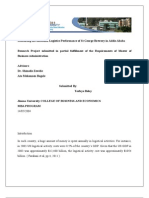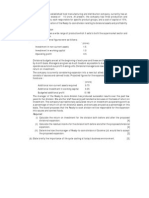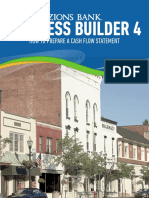Capital Budgeting Worksheet
Capital Budgeting Worksheet
Uploaded by
ImperoCo LLCCopyright:
Available Formats
Capital Budgeting Worksheet
Capital Budgeting Worksheet
Uploaded by
ImperoCo LLCCopyright
Available Formats
Share this document
Did you find this document useful?
Is this content inappropriate?
Copyright:
Available Formats
Capital Budgeting Worksheet
Capital Budgeting Worksheet
Uploaded by
ImperoCo LLCCopyright:
Available Formats
Capital Budgeting Worksheet
Kristoffer Burnett - Certified Management Accountant, 2009-2011
NPV: $ 12,465 Future cash flows discounted back to the present - the initial cash outflow IRR: MIRR: Payback Period: Profitability Index: 17.7% Cost of capital/hurdle rate that would make NPV = $0 16.0% Same as IRR, except the assumption is made that cash flows are reinvested at cost of capital/hurdle rate 9.89 The number of years in which undiscounted cash flows will repay the initial investment 1.14 Equals the present value of all future cash flows / initial investment
$40,000
Net Cash Flow
$20,000
$0
($20,000)
Net Cash Flow
($40,000)
NPV:
($60,000)
($80,000)
Initial
Year 02
Year 05
Year 08
Year 11
Year 14
Year 01
Year 03
Year 04
Year 06
Year 07
Year 09
Year 10
Year 12
Year 13
Year 15
($100,000)
WHITE CELLS ARE ADJUSTABLE
Kristoffer Burnett - Certified Management Accountant, 2009-2011
Capital Budgeting Worksheet
Original cost of old asset(s) $ Salvage value of old asset(s) $ Depreciable life of old asset(s) in years Cost of new asset(s) $ Salvage value of new asset(s) $ Depreciable life of new asset(s) in years Useful life of new asset(s) in years Method of depreciation new asset(s) Effective tax rate 15,000 Price at which old asset could currently be sold Cost of capital/hurdle rate Change in working capital $ 15.0% Cost of capital = the weighted average cost of debt and equity. Hurdle rate = minimum acceptable rate of return. Either can be used (5,000)
1
50,000 Purchase price of asset that is subject to replacement
100,000 Purchase price of replacement asset, including any costs required for use (i.e. transportation, setup, etc.)
10,000 Expected value of old asset after all depreciation is subtracted
25,000 Expected value of new asset after all depreciation is subtracted
10 Number of years old asset is subject to depreciation
10 Number of years new asset is subject to depreciation
Method of depreciation old asset(s) Double Decl. Bal. Different methods will affect taxes Current age of old asset(s) in years Current market value of old asset(s) $
15 Number of years new asset can be utilized
5 Number of years old asset has been owned
MACRS This method does not have to be the same one used for the old asset. 35.0% Rate on income before tax
Initial Year 01 Year 02 Year 03 Year 04 Year 05 Year 06 Year 07 Year 08 Year 09 Year 10 Year 11 Year 12 Year 13 Year 14 Year 15
Capital costs and proceeds (100,000)
Additional costs (995) (817) (1,048) (1,789) (1,651) (1,552) (1,250) (1,681) (1,489) (2,043) (1,505) (1,114) (955) (282) (303)
Taxes (5,170) (5,833) (5,194) (10,113) (9,072) (11,786) (9,251) (9,147) (8,346) (11,057) (8,131) (9,138) (5,221) (2,105) (1,970)
Change in working capital (5,000)
Net sales proceeds of old asset(s) 15,484
Additional revenue 13,373 14,602 14,344 25,978 22,771 29,216 22,671 24,373 22,916 28,210 20,668 22,122 14,287 5,132 4,992
Additional cost savings 2,392 2,881 1,543 4,706 4,800 6,010 5,011 3,442 2,420 5,425 4,068 5,100 1,586 1,164 939
Depreciation tax shield 2,353 5,383 4,870 4,032 3,226 2,580 2,294 2,294 2,294 2,294 1,147
16,250
5,000
Net cash flow (89,516) 11,954 16,215 14,515 22,814 20,074 24,469 19,475 19,281 17,794 22,829 16,247 16,970 9,697 3,909 24,908
Comments
Notes: 1 Working capital equals [current assets - current liabilities]. If working capital will increase due to this project, then that amount should be entered as a negative number. This is because more money will be tied up in things such as inventory or accounts receivable. Conversely, if working capital will decrease, then that amount should be entered as a positive number. 2 The revenue and cost inputs refer to CASH FLOW. Not accrual accounting revenues and costs. 3 The proceeds from the eventual liquidation of the new asset will be net of taxes, if applicable. 4 The proceeds from the liquidation of the old asset, net of taxes (if applicable). 5 Varying amounts of depreciation will affect taxes, and therefore cash flow.
\\vboxsrv\conversion_tmp\scratch_6\159575608.xlsx.ms_office
Page 2 of 2
7/23/20136:25 AM
You might also like
- Break Even AnalysisDocument5 pagesBreak Even Analysisblue_mugNo ratings yet
- FIN202 Test BankDocument294 pagesFIN202 Test BankNguyen Le Khanh Thy (K17 DN)No ratings yet
- Answer:: Option 1 $1 Billion TodayDocument4 pagesAnswer:: Option 1 $1 Billion TodayAshar Khan100% (1)
- More Sample Exam Questions-Midterm2Document6 pagesMore Sample Exam Questions-Midterm2mehdiNo ratings yet
- Financial Management C11 P11Document4 pagesFinancial Management C11 P11lynusannNo ratings yet
- 3 Group Accounts and Business Combinations Lecture NotesDocument47 pages3 Group Accounts and Business Combinations Lecture NotesAKINYEMI ADISA KAMORU100% (5)
- Test Bank CHP 9Document52 pagesTest Bank CHP 9candratriutariNo ratings yet
- Decoding DCF: A Beginner's Guide to Discounted Cash Flow AnalysisFrom EverandDecoding DCF: A Beginner's Guide to Discounted Cash Flow AnalysisNo ratings yet
- Ali EuropeAid Template CV-2012 FDocument16 pagesAli EuropeAid Template CV-2012 FconterNo ratings yet
- Financial Literacy Training - SACCOSDocument54 pagesFinancial Literacy Training - SACCOSFred IlomoNo ratings yet
- Ratio Analysis Case Study SolutionDocument7 pagesRatio Analysis Case Study SolutionRanju100% (1)
- Analysis of Financial StatementsDocument33 pagesAnalysis of Financial StatementsKushal Lapasia100% (1)
- Advanced Taxation CH - 1Document9 pagesAdvanced Taxation CH - 1Mekuriaw MezgebuNo ratings yet
- Couresot LineDocument2 pagesCouresot LineSeifu BekeleNo ratings yet
- Finance & Accounts - INDUCTIONDocument5 pagesFinance & Accounts - INDUCTIONAbhijith S50% (2)
- Advanced Taxation Exam Nov 2010Document10 pagesAdvanced Taxation Exam Nov 2010Kelvin KeNo ratings yet
- ORIO - Template Financial Analysis Tool - Second AppraisalDocument14 pagesORIO - Template Financial Analysis Tool - Second AppraisalMahesh PatilNo ratings yet
- CH 13Document14 pagesCH 13Trang VânNo ratings yet
- Ethiopia International Public Sector Accounting Standards Latest UpdatesDocument8 pagesEthiopia International Public Sector Accounting Standards Latest UpdatesPhoenix Rising100% (1)
- Financial Literacy EducationDocument18 pagesFinancial Literacy EducationAna MariaNo ratings yet
- Shopping Mall Business PlanDocument4 pagesShopping Mall Business PlanJarvys DoumbeNo ratings yet
- Introduction 3Document24 pagesIntroduction 3Zinashbizu LemmaNo ratings yet
- Financial ModelDocument42 pagesFinancial ModelSomnath Kejriwal100% (1)
- Business Plan 2021-2025 FOR Kituuka Juwakali Savings and Credit Cooperative Society LimitedDocument24 pagesBusiness Plan 2021-2025 FOR Kituuka Juwakali Savings and Credit Cooperative Society LimitedOCIRABIDHE CHRISTOPHER VictorNo ratings yet
- Part VIII Legal Frame of Ethiopian Capital Market Mated by DakitoDocument89 pagesPart VIII Legal Frame of Ethiopian Capital Market Mated by DakitoYibeltal AssefaNo ratings yet
- Distinguish Between Production Management and Operation Management. What Is Production Management?Document17 pagesDistinguish Between Production Management and Operation Management. What Is Production Management?Desu Mekonnen100% (1)
- SWOT Analysis. StrengthsDocument3 pagesSWOT Analysis. StrengthsMUHAMMAD ZEESHAN TARIQ100% (2)
- ADP Monitoring DashboardDocument21 pagesADP Monitoring DashboardRana SarkarNo ratings yet
- Cahpet 4.assssssssssssssssssssDocument57 pagesCahpet 4.assssssssssssssssssssSeifu Bekele100% (1)
- Best Answer 3Document14 pagesBest Answer 3Chelsi Christine TenorioNo ratings yet
- Ambachew MekonnenDocument86 pagesAmbachew MekonnenAboma MekonnenNo ratings yet
- 5 Year Financial PlanDocument25 pages5 Year Financial Plananwar kadiNo ratings yet
- Jan 2018Document34 pagesJan 2018alekhya manneNo ratings yet
- Project Appraisal and FinancingDocument52 pagesProject Appraisal and FinancingKapil DharmaniNo ratings yet
- Chapter 3 Project Identification and FeasibilityDocument80 pagesChapter 3 Project Identification and FeasibilityhailegebraelNo ratings yet
- Manual Revenue Enhancement Planning English PDFDocument83 pagesManual Revenue Enhancement Planning English PDFIbroo ShaxaaNo ratings yet
- 5 Year Financial Plan ManufacturingDocument30 pages5 Year Financial Plan ManufacturingLiza GeorgeNo ratings yet
- ACC00724 (Accounting For Managers) S2, 2016 Assignment 1 (20 Marks)Document4 pagesACC00724 (Accounting For Managers) S2, 2016 Assignment 1 (20 Marks)Asfawosen DingamaNo ratings yet
- HRM AssignmentDocument21 pagesHRM AssignmenttotiNo ratings yet
- Audit Group AssignmentDocument21 pagesAudit Group AssignmentEndalkachew BefirdeNo ratings yet
- Determinants of Exchange Rate Movement in EthiopiaDocument8 pagesDeterminants of Exchange Rate Movement in EthiopiaInternational Journal of Innovative Science and Research Technology100% (1)
- BHEL Valuation of CompanyDocument23 pagesBHEL Valuation of CompanyVishalNo ratings yet
- Ethiopian Payroll SystemDocument19 pagesEthiopian Payroll Systemtesematilahun95No ratings yet
- Mhiret Gebre MariamDocument57 pagesMhiret Gebre MariamuvygNo ratings yet
- Chapter 2 Human CapitalDocument8 pagesChapter 2 Human CapitalkasuNo ratings yet
- Financial Projections TemplateDocument214 pagesFinancial Projections TemplateReselyn PalabinoNo ratings yet
- Audit Feam WoDocument12 pagesAudit Feam Woamanawite TeshomeNo ratings yet
- Investment Incentives in EthiopiaDocument2 pagesInvestment Incentives in EthiopiaErmias SimeNo ratings yet
- Question No: 1 (Marks: 1) - Please Choose OneDocument15 pagesQuestion No: 1 (Marks: 1) - Please Choose OneHassanalizaidi100% (1)
- Performance 6.10Document2 pagesPerformance 6.10George BulikiNo ratings yet
- 30 Pages Article-Implementation Challenges of The Service Delivery Policy of Ethiopia - Civil Servants' Perspective-Bezabih BDocument30 pages30 Pages Article-Implementation Challenges of The Service Delivery Policy of Ethiopia - Civil Servants' Perspective-Bezabih BChuchure Teka100% (5)
- Tor Guidance For Mid Term Evaluation ArDocument30 pagesTor Guidance For Mid Term Evaluation ArAwol AminNo ratings yet
- Chapter-2-4 Facilities LocationDocument40 pagesChapter-2-4 Facilities LocationAddisuNo ratings yet
- Interpretation of Financial Statements - Use This Copy.Document38 pagesInterpretation of Financial Statements - Use This Copy.muzaire solomon100% (1)
- Strategic Planning and Implementation & Strategic Marketing ManagementDocument16 pagesStrategic Planning and Implementation & Strategic Marketing Managementyuvraj9898No ratings yet
- Ratio Analysis of Bank Al Habib Limited, Habib Metropolitan Bank Limited and J.S Bank Limited For Financial Year 2013, 2014 and 2015Document11 pagesRatio Analysis of Bank Al Habib Limited, Habib Metropolitan Bank Limited and J.S Bank Limited For Financial Year 2013, 2014 and 2015Mubarak HussainNo ratings yet
- Preparing CASH FLOW StatementDocument20 pagesPreparing CASH FLOW StatementNavaraj BaniyaNo ratings yet
- Belay ThesisDocument34 pagesBelay ThesisTesfaye HirpasaNo ratings yet
- WRFWRF Topic 2 - Financial Planning - Lecture Notes (2021 Adj)Document19 pagesWRFWRF Topic 2 - Financial Planning - Lecture Notes (2021 Adj)Govardan SureshNo ratings yet
- Ballerina Tech Assumptions & SummaryDocument48 pagesBallerina Tech Assumptions & Summaryapi-25978665No ratings yet
- Tsigemariam LegesseDocument89 pagesTsigemariam Legessedagim ayenewNo ratings yet
- Project Analysis Chapter SixDocument6 pagesProject Analysis Chapter Sixzewdie100% (1)
- FA2A - Study GuideDocument67 pagesFA2A - Study GuideHasan EvansNo ratings yet
- Excessive Inventory AnalysisDocument23 pagesExcessive Inventory AnalysisImperoCo LLCNo ratings yet
- Resource Utilization ExampleDocument4 pagesResource Utilization ExampleImperoCo LLCNo ratings yet
- Weighted Average Cost of Capital WorksheetDocument2 pagesWeighted Average Cost of Capital WorksheetImperoCo LLCNo ratings yet
- Direct Material Variance ExampleDocument1 pageDirect Material Variance ExampleImperoCo LLCNo ratings yet
- Revenue Variance ExampleDocument1 pageRevenue Variance ExampleImperoCo LLCNo ratings yet
- Flexible Budget ExampleDocument2 pagesFlexible Budget ExampleImperoCo LLCNo ratings yet
- Activity Based Costing ExampleDocument3 pagesActivity Based Costing ExampleImperoCo LLCNo ratings yet
- Departmental Expense Breakdown: Process Costing ExampleDocument5 pagesDepartmental Expense Breakdown: Process Costing ExampleImperoCo LLCNo ratings yet
- Job Order Costing ExampleDocument3 pagesJob Order Costing ExampleImperoCo LLCNo ratings yet
- Expected Value WorksheetDocument1 pageExpected Value WorksheetImperoCo LLCNo ratings yet
- Linear Programming ExampleDocument1 pageLinear Programming ExampleImperoCo LLCNo ratings yet
- Financial Budget Example: White Cells Are AdjustableDocument5 pagesFinancial Budget Example: White Cells Are AdjustableImperoCo LLCNo ratings yet
- Operating Budget ExampleDocument10 pagesOperating Budget ExampleImperoCo LLCNo ratings yet
- AIS ExamDocument15 pagesAIS ExamLouie De La Torre100% (1)
- Chapter 7. Student CH 07-15 Build A Model: AssetsDocument3 pagesChapter 7. Student CH 07-15 Build A Model: Assetsseth litchfieldNo ratings yet
- JC Bookkeeping and Accounts 2022 Question Paper 2Document14 pagesJC Bookkeeping and Accounts 2022 Question Paper 2samwelmarium208No ratings yet
- Sunway University College THE INSTITUTE OF CHARTERED ACCOUNTANTS (ICAEW) Programme 2010Document12 pagesSunway University College THE INSTITUTE OF CHARTERED ACCOUNTANTS (ICAEW) Programme 2010Sunway University100% (1)
- MDL 09 PDFDocument94 pagesMDL 09 PDFUm ShagizNo ratings yet
- Metro HR PoliciesDocument15 pagesMetro HR PoliciesSadeeq KhanNo ratings yet
- Curriculum Vitae Sample of An AccountantDocument8 pagesCurriculum Vitae Sample of An Accountante6zwz633100% (1)
- Foreign Currency TranslationsDocument29 pagesForeign Currency TranslationsJenica Diasmen PabayoNo ratings yet
- Answer To Q On IFRS 9Document4 pagesAnswer To Q On IFRS 9johny SahaNo ratings yet
- Chap 7 (Ii) Standard Setting Political IssuesDocument13 pagesChap 7 (Ii) Standard Setting Political IssuesGayatri Panirselvam -No ratings yet
- Implementing Rules and RegulationsDocument6 pagesImplementing Rules and RegulationsKristian Jon PutalanNo ratings yet
- BKSL 2013 ArDocument100 pagesBKSL 2013 ArPanama TreasureNo ratings yet
- Abay Bank Call Written Exam For The Post of Customer Service OfficerDocument36 pagesAbay Bank Call Written Exam For The Post of Customer Service OfficerGetacher Niguse100% (1)
- Auditing NotesDocument3 pagesAuditing NotesLeimonadeNo ratings yet
- Suggested Answer CAP I June 2011Document83 pagesSuggested Answer CAP I June 2011alchemistNo ratings yet
- Relevant Costing Simulated Exam Ans KeyDocument5 pagesRelevant Costing Simulated Exam Ans KeySarah BalisacanNo ratings yet
- Sun Developers & Consultants: Date Invoice # Bill Amount Credit Amount Balance RemarksDocument7 pagesSun Developers & Consultants: Date Invoice # Bill Amount Credit Amount Balance Remarksrajts singhNo ratings yet
- COST ANALYSIS - 62 Questions With AnswersDocument6 pagesCOST ANALYSIS - 62 Questions With Answersmehdi everything100% (1)
- BG Creation: Submitted By: Santhosh Kumar Focusr Consultancy and Technologies Private LimitedDocument30 pagesBG Creation: Submitted By: Santhosh Kumar Focusr Consultancy and Technologies Private LimitedSanthosh SantyNo ratings yet
- Zahirul Ch.1, Accounting For Strategic ManagementDocument12 pagesZahirul Ch.1, Accounting For Strategic ManagementMUHAMMAD NAUFAL RAMADHANNo ratings yet
- Unit 2 Current Event (ACCT-422-WB-10)Document2 pagesUnit 2 Current Event (ACCT-422-WB-10)tomomiy907No ratings yet
- RM RM Sales (14,000 X RM120) (-) Cost of Goods Sold:: (-) Overapplied Fixed Overhead (2,500)Document2 pagesRM RM Sales (14,000 X RM120) (-) Cost of Goods Sold:: (-) Overapplied Fixed Overhead (2,500)Sofia ArissaNo ratings yet
- Internal Audit For Organizational Resilience: Balancing Assurance - Advisory-AnticipateDocument70 pagesInternal Audit For Organizational Resilience: Balancing Assurance - Advisory-Anticipatemikael abubakarNo ratings yet
- Chapter 02 Financial Statements AnalysisDocument15 pagesChapter 02 Financial Statements AnalysisAliceJohnNo ratings yet
- p2 Guerrero Ch8 CompressDocument18 pagesp2 Guerrero Ch8 CompressLaiza Grace FabreNo ratings yet
- MailDocument4 pagesMailsandosNo ratings yet






































































































